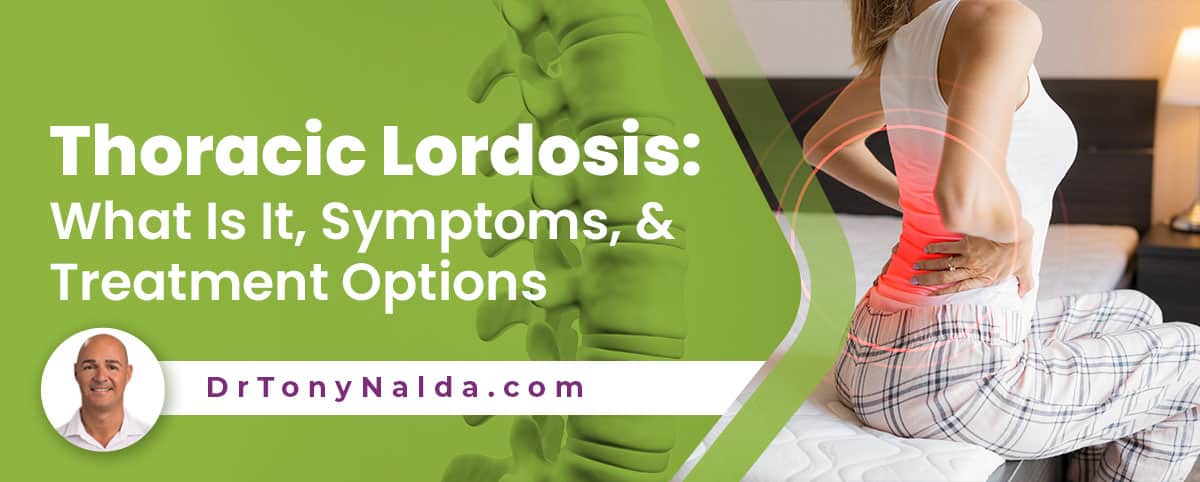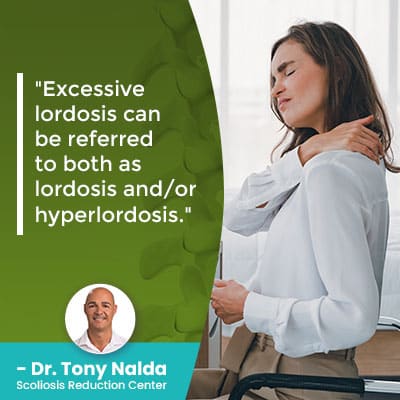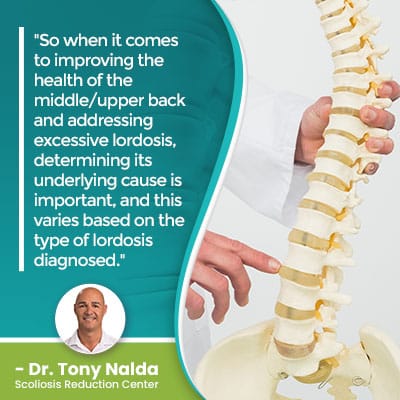Thoracic Lordosis: What Is It, Symptoms, & Treatment Options

In a healthy spine, its natural curves and alignment are in place, but there are a number of spinal conditions that cause a loss of those healthy curves, such as scoliosis, kyphosis, and lordosis. Continue reading to understand the role of healthy spinal curves and learn more about thoracic lordosis, in particular.
The spine has three main sections, and the thoracic spine is the largest, including the middle/upper back. Being diagnosed with thoracic lordosis means the thoracic spine has developed an excessive inward curvature and can give the body a swayback appearance.
As the spine's natural curves are so important, let's start with why.
Table of Contents
Natural and Healthy Spinal Curvatures
The spine does a lot for us; it helps us to stand upright and practice good posture, protects internal organs, gives the body structure, facilitates flexible movement, and the spinal cord within works in tandem with the brain to form the body's central nervous system (CNS).
It's because of these roles that spinal conditions can cause a host of issues felt throughout the body, and not just in and around the spine.
The spine has three main sections, and each has its own characteristic curvature type: cervical spine (neck), thoracic spine (middle/upper back), and the lumbar spine (lower back).
The two main spinal curvature types are kyphosis and lordosis. Kyphosis refers to a spinal curve that bends outwards, away from the body's center, while lordotic curves bend inwards, towards the body's center.
The spine's kyphotic curve is found in the thoracic section, while the cervical and lumbar spine feature lordotic curves.
Now, there is a natural range of curvature sizes that vary from person to person, but if the size of a spinal curve falls beyond a healthy range, problems occur.
A healthy cervical spine has a typical lordotic range of 20 to 40 degrees, with the lumbar spine having a healthy range of between 40 and 60 degrees; a healthy range of thoracic kyphosis falls within 20 to 40 degrees.
So what happens if the thoracic spine loses its natural kyphosis and becomes excessively lordotic?
What is Thoracic Lordosis?
As mentioned, the thoracic spine's natural and healthy curve is kyphotic, meaning the spine curves outwards.
If a person experiences a loss of their natural kyphosis, the thoracic spine can develop an excessive lordotic curve; this means the spine bends excessively inwards where it shouldn't, and this introduces uneven forces to the spine, its surrounding muscles and nerves, and the entire body.
 Excessive lordosis can be referred to both as lordosis and/or hyperlordosis.
Excessive lordosis can be referred to both as lordosis and/or hyperlordosis.
Symptoms of Thoracic Lordosis
While each case is unique, common symptoms associated with thoracic lordosis can include:
- Postural changes
- The inability to lay flat on the floor without a noticeable gap between the floor and the thoracic spine
- Varying levels of back pain
- Nerve compression and radiating pain
- Mobility issues
The main way in which the condition affects posture is by causing a swayback appearance, as the excessive lordotic curve pushes the abdomen forward and the buttocks backward to protrude excessively.
The inability to lay flat on the floor with the entire spine in contact with the surface below is due to the fact that there is a structural abnormal curve, meaning that no change in position can alter it, unlike postural lordosis which is non-structural.
Back pain related to thoracic lordosis can range from mild and intermittent to chronic and debilitating, depending on a number of factors such as patient age, overall health, the degree of nerve involvement, and condition severity.
When the spine is unnaturally curved, its ability to handle mechanical stress incurred during activity is disrupted, and if lordosis develops in the thoracic spine, this also affects the spinal cord and spinal nerve roots where they exit the spine.
Nerves need space to function within, and if an excessive curvature develops, it can introduce uneven pressure (compression) to the nerves within, and this can cause pain that radiates throughout the body; remember, nerves are like limbs of a tree, branching off in different directions.
If a spinal nerve is compressed, pain can be felt anywhere along its pathway, which is why nerve pain can be felt far from its site of origin.
When it comes to mobility issues, this can be related to nerve and/or muscle issues. In general, the area of the body located closest to the affected spinal section is the most likely to feel its direct effects, and the postural change that thoracic lordosis causes can lead to mobility issues felt throughout the trunk and lower body.
Thoracic Lordosis Treatment Options
When it comes to treating thoracic lordosis, treatment plans need to be fully customized to address key patient/condition variables.
Here at the Scoliosis Reduction Center, I've been treating a wide range of spinal conditions, thoracic lordosis included, for over 20 years, and while there are never treatment guarantees, my conservative chiropractic-centered treatment approach has produced some impressive results.
 So when it comes to improving the health of the middle/upper back and addressing excessive lordosis, determining its underlying cause is important, and this varies based on the type of lordosis diagnosed.
So when it comes to improving the health of the middle/upper back and addressing excessive lordosis, determining its underlying cause is important, and this varies based on the type of lordosis diagnosed.
There are five main types of lordosis: postural, congenital/traumatic, post-surgical, neuromuscular, and lordosis that's related to hip flexion contracture.
Postural Lordosis
Postural lordosis is the simplest to treat because it's not a structural condition; it's commonly caused by obesity and poor muscle strength so the spine isn't supported adequately.
When there is excess weight on a person's mid-section, it can pull the back forward, and this impacts the spinal muscles, making them weak and unable to support the spine properly, and this can lead to the spine developing an unnatural lordotic curve.
So treatment for postural lordosis involves lifestyle guidance and changes that focus on weight loss and physical therapy to help increase core strength so the spine can be supported and stabilized by its surrounding muscles.
Congenital/Traumatic Lordosis
In cases of congenital lordosis, babies are born with the condition due to a defect in the spine that develops in utero, specifically in the pars that connect the vertebrae (bones of the spine).
Cases of traumatic lordosis can be caused by sports injuries, an accident, or trauma, including tumors pressing on the spine and forcing it out of alignment.
Whether a bone connection is broken due to a weak pars that develops in utero, or a sports injury/trauma, treatment needs to start with rest and activity restrictions so the spine can heal.
Once the spine has healed through rest, conditions need to be impacted on a structural level to address the structural abnormality within the spine, and this can involve condition-specific chiropractic care and corrective bracing.
Post-Surgical Hyperlordosis
In many cases of post-surgical hyperlordosis, this involves a laminectomy removing parts of the vertebrae to access the spinal cord and nerve roots, but the more this is done, the more unstable the spine becomes and the more likely it is to develop a hyperlordotic curve.
The removal of spinal cord tumors in children, for example, can lead to hyperlordosis.
Effective treatment will involve restoring as much of the healthy spinal curves as possible through chiropractic care, and increasing core strength through physical therapy so the spine's healthy curves/alignment can be maintained.
Neuromuscular Lordosis
As the name suggests, neuromuscular lordosis develops as a secondary complication of a larger neuromuscular condition such as muscular dystrophy, spina bifida, and cerebral palsy, to name a few.
In these types of cases, there is a disconnect between the brain, muscles, and connective tissues that support the spine, making it difficult for the spine to maintain its natural curves/alignment.
Cases of neuromuscular lordosis can only be treated effectively by first addressing the larger neuromuscular condition that caused its development.
Hip Flexion Contracture-Related Lordosis
Hip flexion contracture-related lordosis are rare cases that develop when the hip joints' connective tissues that are generally elastic in nature, become more fibrous and less flexible.
When the connective tissues in the hip become excessively stiff, it can cause movement issues and patterns, affecting gait, the lower thoracic spine, and leading to excessive lordosis.
Hip-flexion contracture can be caused by injury, infection, muscle imbalances, or the presence of another condition.
When it's determined that a muscle imbalance is the cause, physical therapy that includes a number of condition-specific exercises and treatment can work towards increasing core strength and spinal flexibility.
Conclusion
The spine's natural curves are important, and when the spine experiences a loss of its natural curves, it can become weaker, less flexible, not as efficient at absorbing and distributing mechanical stress, and this can cause excess wear and tear, adverse spinal tension, and uneven forces being exposed to the spine and body.
A diagnosis of thoracic lordosis means that the thoracic spine has developed an excessive degree of lordosis, and the most noticeable symptom is how it affects body positioning and posture: causing a swayback appearance.
As there are different types of lordosis with different causes, treatment plans have to be fully customized to address a condition's underlying cause which can be postural, structural, and/or related to the presence of other conditions that affect the spine's surrounding muscles.
Here at the Center, I treat patients with thoracic lordosis proactively by starting treatment as close to the time of diagnosis as possible; this is because spinal conditions tend to get worse over time, particularly once natural age-related spinal degeneration comes into play.
Dr. Tony Nalda
DOCTOR OF CHIROPRACTIC
After receiving an undergraduate degree in psychology and his Doctorate of Chiropractic from Life University, Dr. Nalda settled in Celebration, Florida and proceeded to build one of Central Florida’s most successful chiropractic clinics.
His experience with patients suffering from scoliosis, and the confusion and frustration they faced, led him to seek a specialty in scoliosis care. In 2006 he completed his Intensive Care Certification from CLEAR Institute, a leading scoliosis educational and certification center.
About Dr. Tony Nalda
 Ready to explore scoliosis treatment? Contact Us Now
Ready to explore scoliosis treatment? Contact Us Now





